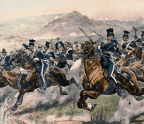

The very mention of the world’s great fortresses often inspires admiration—Masada, the Alamo, Gibraltar. Such names recall battles synonymous with heroic resistance and national pride. The history of Kars, however, is one of continual strife, humiliating treaties and the final betrayal and embarrassment of a proud people.
The origin of the name Kars is itself a matter of continuing dispute—is it Kars, Qers or Qars? Is it of Armenian, Georgian or Turkish origin? The fortress lies just west of the Turkish-Armenian border on the Akhuryan (or Arpachay) River, between the Black and Caspian seas and south of the Caucasus Mountains. The great historical empires of Persia, Ottoman Turkey and Russia intersected in the region. Also claiming ground here at various times were the Armenians, Byzantines and Mongols.

Coalescing around this hub of empires in the 4th century BC was the Kingdom of Armenia, which in AD 301 became the first state in the world to adopt Christianity as its official religion. With the later rise of Islam to the south and east, the kingdom became increasingly isolated and vulnerable.
In the 9th century, with the threat of Muslim invasion ever present, the Armenians built the first fortifications at Kars, on the rocky heights overlooking the regional capital. Byzantine forces seized the stronghold in the mid-11th century, only to relinquish it a few years later to the Seljuk Turks. Kars changed hands several times between the Turks and Georgians until 1387, when feared Mongol conqueror Timur (better known in the West as Tamerlane) wrested the city from its cowed defenders and incorporated it into his empire. Turks retook the city in 1585, declared it neutral and destroyed its fortifications. It remained under Ottoman rule in the 18th century when Sultan Murad III rebuilt the stronghold to block Persian encroachment in the region, touching off the 1730–35 Ottoman-Persian War.
Although not as comprehensive as the earlier military outworks of




